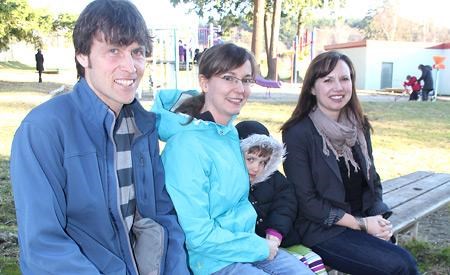A group of parents is working with James Thomson Elementary School community to develop not just a new approach to playgrounds but a new approach to learning.
Discover Imagine Grow Schoolyard, or DIGS, is an initiative led by parents of students at James Thomson together with the school’s administration to re-envision the school’s playground. The idea is to bring natural features to the schoolyard to make it a space conducive to healthy play and learning.
The project has four projected components. The first is a greening of the yard, including edible and other types of gardens. Second is incorporating an outdoor classroom or gathering space, such as a natural amphitheatre. Upgrading the playground, including the equipment, is the third component and improving the pavement through added games and designs is the fourth.
“I think creating a beautiful, diverse, natural outdoor playscape for a child just has so many health benefits,” said organizer Leta Burechailo.
The initiative is in its early phases but ready to mature. The group spearheading the plan has appealed to all essential stakeholders and is now turning to the parents, students, staff and community around James Thomson for ideas on how to go forward. DIGS organizers said the timeline for the project is entirely dependent on how big or little those involved want the project to be. Also, although the four components are viewed as a starting point there are no restrictions on brainstorming.
This will be achieved through public design workshops that are being organized. Jon van Oostveen, one of the members of the DIGS team, is an architect and will be distributing a site plan at these workshops that participants can then look at and come up with a wish list. Van Oostveen and the others will take that wish list and use it to come up with a plan to take back to the school community for approval or modification.
“What we’ll do is...try to inspire lots of ideas and thinking and then say ‘okay, in an ideal situation, what would you like to see here?’” said van Oostveen. “It’s bringing complexity to kind of a homogenous landscape and with that complexity comes lots of creative inspiration.”
Other schools are leading the way and experimenting with the natural playground approach to play. In a presentation to the Powell River Board of Education the DIGS group talked about Grandview Elementary School in East Vancouver where volunteers transformed the playground to include trees, a water feature, outdoor learning spaces and even a climbing boulder.
Recent studies, including Grounds for Action, a 2006 study prepared for Evergreen, a national charity that promotes naturalized playgrounds, find that natural schoolyard settings promote increased physical activity and can benefit an entire school, both in and out of the classroom. Rather than pavement-based playgrounds, natural settings are found to provide a variety of physical activities and learning opportunities.
A general concept is in place for James Thomson that includes a desire for more natural features, an outdoor learning space and an edible garden, but the specifics are entirely open for suggestions. The plan is also to include elements of Tla’Amin (Sliammon) First Nations’ culture into the design and to tie the project into the environmental aspects of the school’s eco-immersion program.
Burechailo said James Thomson is a good school to approach with this plan because it is in need of a new playground and because it already has some excellent natural features. The Parent Advisory Committee (PAC) at the school has been raising money for playground upgrades and is on board with DIG’s plans. There is a forested area of the playground that Jasmin Marshman, school principal, said students love to play in and a garden is already in the works through the Farm to School program that started this year.
“There’s a lot that ties into curriculum that teachers are excited about,” said Marshman, such as “having that gathering space to be able to say ‘let’s take math outside.’”
Grants, combined with volunteer work, are expected to take care of the cost of the project. The timeframe for the project is between one to three years, depending on its scale, which will be determined by the input. The edible garden aspect is planned to begin this spring.



